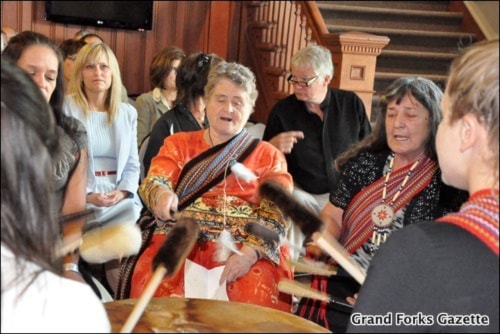School District 51 (SD51), the provincial government and local aboriginal leaders renewed the Boundary Aboriginal Education Enhancement Agreement on June 27 at Gallery 2, after five years of positive results.
Originally signed and created in 2006, the success in the district is seen in the numbers of students succeeding in schools.
There was an increase in aboriginal graduation rates, from 69 per cent in the 2005-2006 school year to 86.7 per cent in 2010-2011.
Roughly 25 per cent of Boundary students claim aboriginal ancestry.
“The province is committed to helping aboriginal students succeed,” said Boundary-Similkameen MLA John Slater. “I’ve been to a couple of these ceremonies and it’s important for communities to keep going. We want to make sure our achievements keep on continuing.”
Slater noted that though aboriginal students are achieving greater success, there is still work to do.
“The signatories that are signing this agreement are committed to working together in a shared decision, making a model focused on the education of students in the district,” he said.
Ted Cadallader, the Enhancement Agreement co-ordinator with the Aboriginal Education department of the Ministry of Education, agreed.
“We have to find ways to ensure that all of our students have an awareness of aboriginal culture and language and history as they go through with their education,” he said.
The renewed agreement represents an ongoing commitment between the SD51, local Aboriginal communities and the Ministry of Education.
The agreement emphasizes the balance between physical and spiritual needs for students, based off the concept of the medicine wheel.
“Through a continuing collaborative partnership between all parties we are committed to improving educational achievement for all Aboriginal students,” said Maxine Ruzicka, the school board’s director for instruction. “We proudly acknowledge this collective relationship of shared responsibility and decision making to set goals to meet the educational needs of Aboriginal students.”
The agreement was created with extensive community consultation from the Boundary Métis Community Association and Boundary All Nations Aboriginal Council (BANAC).
The historical agreement was signed by Danny Williamson of the Boundary Métis Association, Joan Holmes, president of the BANAC, Terry Jackson of the Boundary Métis Association, Cadallader of the Ministry of Education, SD51 board chair Teresa Rezansoff, SD51 trustee Vicki Gee, SD51 Superintendent Michael Strukoff, Ruzicka, Slater, Boundary Family and Individual Services Society Aboriginal Family support worker Erika Schoenfeld, Grand Forks Secondary School Aboriginal Family support worker Victoria Runge, teachers Wanda Hecht and Marilyn Hanson and SD51 administrator Jennifer Turner.
SD51 receives roughly $1,000 per aboriginal student a year from the provincial government but directs the funds to achieving goals within the Aboriginal Enhancement Agreement.
SD51 is one of 53 school districts in the province with an Aboriginal enhancement agreement. Since the original agreement, 11 have signed a second five-year agreement and four have signed a third.
